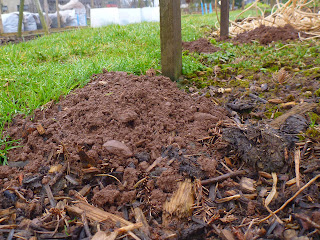Managing Mr Mole
I have noticed some molehills on my allotment, and also some down near the gate, so I decided to do a little research about moles.
The mole is a small mammal – about 6” long, with a black or grey pelt. It has a long body, suited to living in underground runs; tiny ears and eyes but enormous powerful front claws, which it uses for digging. The mole is related to the hedgehog and it eats worms, slugs and other soil-dwelling invertebrates. It doesn’t eat plant roots. The mole is a common mammal, but you will rarely see one – just the mounds of earth it throws up whilst tunnelling. In medieval times it was called a moldewarp (earth thrower).
So far, so good (it eats slugs). However, the mole seems to have received a bad press. The internet is full of adverts for traps and suggestions - mostly from Americans - about blasting them with a shotgun. There are also lots of poisons you could use but obviously this wouldn’t do your soil and plants much good so are best avoided. The best tip seems to be using little windmills or a bottle on a stick in the ground. The vibrating noise prevents the mole from hearing the worms and he may well move over onto your neighbours plot instead.
From what I’ve learned, moles really aren’t too much of a problem. They live alone in their tunnels just eating the worms which fall in. The tunnels are deep below the surface and most of the time you will never even know the mole is there.
However, occasionally the need for some more tunnels will arise. This may be during the breeding season (Feb – May), when the males will go in search of a female, or it may be a new mole making a home for itself. During this time, the mole has to bring the excavated earth to the surface and he may inadvertently burrow under your plant roots. This could undermine and potentially kill young plants.
On balance, if you only have the odd mole, it's very unlikely you will experience any damage from its activities. The molehills themselves are just unsightly. Simply remove the earth – in fact, it makes a really good soil-based potting compost.
As always, I will be leaving nature alone and feeling grateful for the diversity of wildlife on my plot.
The mole is a small mammal – about 6” long, with a black or grey pelt. It has a long body, suited to living in underground runs; tiny ears and eyes but enormous powerful front claws, which it uses for digging. The mole is related to the hedgehog and it eats worms, slugs and other soil-dwelling invertebrates. It doesn’t eat plant roots. The mole is a common mammal, but you will rarely see one – just the mounds of earth it throws up whilst tunnelling. In medieval times it was called a moldewarp (earth thrower).
So far, so good (it eats slugs). However, the mole seems to have received a bad press. The internet is full of adverts for traps and suggestions - mostly from Americans - about blasting them with a shotgun. There are also lots of poisons you could use but obviously this wouldn’t do your soil and plants much good so are best avoided. The best tip seems to be using little windmills or a bottle on a stick in the ground. The vibrating noise prevents the mole from hearing the worms and he may well move over onto your neighbours plot instead.
From what I’ve learned, moles really aren’t too much of a problem. They live alone in their tunnels just eating the worms which fall in. The tunnels are deep below the surface and most of the time you will never even know the mole is there.
However, occasionally the need for some more tunnels will arise. This may be during the breeding season (Feb – May), when the males will go in search of a female, or it may be a new mole making a home for itself. During this time, the mole has to bring the excavated earth to the surface and he may inadvertently burrow under your plant roots. This could undermine and potentially kill young plants.
On balance, if you only have the odd mole, it's very unlikely you will experience any damage from its activities. The molehills themselves are just unsightly. Simply remove the earth – in fact, it makes a really good soil-based potting compost.
As always, I will be leaving nature alone and feeling grateful for the diversity of wildlife on my plot.
Submitted by Jane, plot 9

Comments
Post a Comment